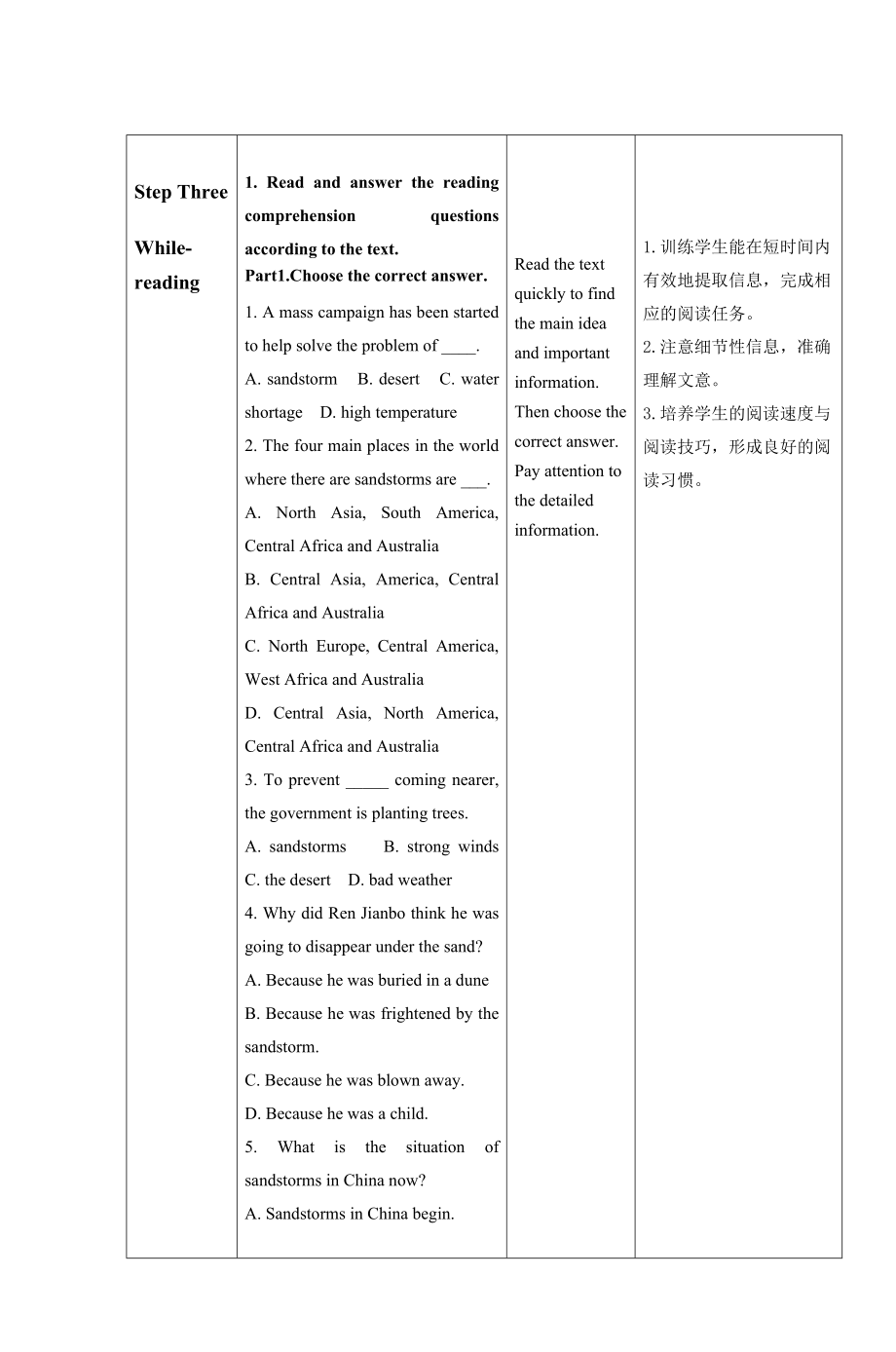




版權(quán)說(shuō)明:本文檔由用戶提供并上傳,收益歸屬內(nèi)容提供方,若內(nèi)容存在侵權(quán),請(qǐng)進(jìn)行舉報(bào)或認(rèn)領(lǐng)
文檔簡(jiǎn)介
1、Sandstorms in Asia(外研版高中英語(yǔ)必修3第4模塊)姓名彭靜單位西鄉(xiāng)二中課型閱讀課課時(shí)第2課時(shí)教學(xué)對(duì)象高一(6)班是否采用多媒體是一、教材分析 本模塊主題是“Sandstorms in Asia”, 亞洲的沙塵暴。沙塵所挾帶的污染物和有毒重金屬,對(duì)環(huán)境和人體健康造成影響。沙塵暴轉(zhuǎn)趨頻繁,是全球自然災(zāi)害日增大趨勢(shì)的一部分。根據(jù)估計(jì),沙塵暴每年造成的綜合經(jīng)濟(jì)損失可達(dá)65億美元。READING AND VOCABULARY合并為第二課時(shí)“閱讀課”。課文“Sandstorms in Asia”屬說(shuō)明文體,介紹了沙塵暴的特點(diǎn)、世界沙塵暴重災(zāi)區(qū)和中國(guó)面臨的沙塵暴和荒漠化問(wèn)題。對(duì)于閱讀課如何
2、上,師生各有己見(jiàn)。但閱讀的目的就是培養(yǎng)閱讀策略,培養(yǎng)語(yǔ)感,特別是培養(yǎng)學(xué)生在閱讀的過(guò)程中獲取和處理信息的能力。在這個(gè)過(guò)程中教師起著鼓勵(lì),啟發(fā),引導(dǎo),幫助,監(jiān)控,參與,反饋與評(píng)價(jià)的作用二、學(xué)情分析我所帶的學(xué)生英語(yǔ)基礎(chǔ)較差,在閱讀的基本能力方面學(xué)生的猜詞義,推理判斷能力較差。基于此在有限的課堂教學(xué)中,著重培養(yǎng)這方面能力和給予學(xué)生啟發(fā)和思考是教師的第一要?jiǎng)?wù)。 本節(jié)課vocabulary為其內(nèi)容之一,活動(dòng)2,3均為詞義理解的練習(xí),但學(xué)生多習(xí)慣于學(xué)之前先學(xué)習(xí)詞匯,這也是降低閱讀難度的策略,但學(xué)生會(huì)減少在文中根據(jù)語(yǔ)境理解詞義的機(jī)會(huì),為此可以把這兩個(gè)活動(dòng)改為通過(guò)語(yǔ)境加深理解詞義,掌握運(yùn)用生詞的活動(dòng)。課前預(yù)習(xí),
3、課中檢查核對(duì),暴露學(xué)生理解中的問(wèn)題,指導(dǎo)學(xué)生提高理解能力。三、教學(xué)資源與策略本節(jié)課除外研版必修3教材、錄音資料外,還借鑒了英語(yǔ)周報(bào)、優(yōu)化探究和金色教案中的一些好的方面,同時(shí)也通過(guò)互聯(lián)網(wǎng)搜索了有關(guān)沙塵暴的一些資料和圖片。主要采用的教學(xué)策略有: 任務(wù)型閱讀教學(xué)法和交際式教學(xué)法。四、教學(xué)目標(biāo)1.Knowledge:Learn the follow words and phases: mass,campaig,dune,desertification,process,citizen,dust,forecast,strength,cycle,mask,be caught in, a terrible e
4、xperience, in desert areas, in recent years, as a result of, cut down trees and dig up grass. 2.Skills:Train students' ability of summarizing.Train students' ability of understanding the vocabulary by learning in the real context.Understand the text and the logic links and then get the infor
5、mation to answer the questions.3.Cultural consciousness and feelings:Learn the situation of the world environmental protection and strengthen their realization.五、教學(xué)重難點(diǎn)【教學(xué)重點(diǎn)】1. Make students learn the language points by teachers' questions and students' thinking and apply the points by compar
6、ing and practice, thus the students finish their self-learning. 2. Learn the structure by understanding the profile of each paragraph. 3. Learn to find and deal with the information in reading to improve students' abilities of analyzing and solving problems.【教學(xué)難點(diǎn)】1. Analyse and deal with the tex
7、t and finish the activities with the expressions they learnt. 2. Make students have a habit of self-learning.六、教學(xué)過(guò)程教學(xué)環(huán)節(jié)教師活動(dòng)學(xué)生活動(dòng)設(shè)計(jì)意圖Step OneLeading-inPlease look at the photo on the screen. What is it? Yes, it is sandstorms.Now do you want to know more about sandstorms in our country? Please turn to
8、page 32.1.Apprreciate these pictures 2. Discuss some questions通過(guò)圖片的展示讓學(xué)生感受沙塵暴,并試著用恰當(dāng)?shù)男稳菰~來(lái)描繪沙塵暴,說(shuō)出沙塵暴最嚴(yán)重的地方,引出課題- Sandstorms in Asia.Step TwoPre-readingRead the title “Sandstorms in Asia”, ask students to suppose what the article will talk about.Discuss and predict the topic actively in groups.通過(guò)討論猜測(cè)
9、的形式鍛煉學(xué)生的積極思考的習(xí)慣,在此基礎(chǔ)上閱讀下文會(huì)更有目的性。Step ThreeWhile-reading1. Read and answer the reading comprehension questions according to the text.Part1.Choose the correct answer.1. A mass campaign has been started to help solve the problem of _.A. sandstorm B. desert C. water shortage D. high temperature2. The fo
10、ur main places in the world where there are sandstorms are _. A. North Asia, South America, Central Africa and Australia B. Central Asia, America, Central Africa and Australia C. North Europe, Central America, West Africa and Australia D. Central Asia, North America, Central Africa and Australia 3.
11、To prevent _ coming nearer, the government is planting trees. A. sandstorms B. strong winds C. the desert D. bad weather4. Why did Ren Jianbo think he was going to disappear under the sand?A. Because he was buried in a duneB. Because he was frightened by the sandstorm.C. Because he was blown away.D.
12、 Because he was a child.5. What is the situation of sandstorms in China now?A. Sandstorms in China begin.B. Sandstorms in China appear in recent years.C. Sandstorms in China begin to increase.D. Sandstorms in China seem to have increased in recent years.Part2. Listen to the text carefully and decide
13、 how many parts this article can be divided into.Part I (para.1):Part II (para.2-5):Part (para.6):Read the text quickly to find the main idea and important information. Then choose the correct answer.Pay attention to the detailed information.Listen to the text carefully once again to decide how many
14、 parts this article can be divided into.1.訓(xùn)練學(xué)生能在短時(shí)間內(nèi)有效地提取信息,完成相應(yīng)的閱讀任務(wù)。2.注意細(xì)節(jié)性信息,準(zhǔn)確理解文意。3.培養(yǎng)學(xué)生的閱讀速度與閱讀技巧,形成良好的閱讀習(xí)慣。通過(guò)聽(tīng)錄音一方面培養(yǎng)了學(xué)生的聽(tīng)力;另一方面進(jìn)一步加深了學(xué)生對(duì)課文內(nèi)容的整體理解和掌握,形成對(duì)文章框架的正確認(rèn)知,從而增強(qiáng)閱讀能力和語(yǔ)篇分析能力。Step FourPostreadingComplete the article with one word in each blankA sandstorm is a major _1_ for many Asian coun
15、tries. Being strong, dry winds carrying _2_. Sandstorms are often so thick that you cannot see the sun, and the wind is sometimes _3_ enough to move sand dunes. The four main places in the world where sandstorms _4_ found are Central Asia, North America, Central Africa and Australia. Northwest _5_ i
16、s part of the sandstorm center in Central Asia. Sandstorms sometimes come to Beijing. Citizens _6_ up to an orange sky and strong winds. The storms sometimes go on all _7_ and traffic becomes very slowly.The Chinese Central Weather Station is _8_ to forecast a sandstorm some weeks before it arrives
17、in Beijing, but its strength _9_ terrifies people. The desert is only 250 kilometers away to the west of _10_. To prevent it coming nearer, the government is planting trees.According to the text, put appropriate words in the blanks.通過(guò)給短文填空的形式進(jìn)行課文的復(fù)述,一方面降低了難度,另一方面讓學(xué)生能學(xué)會(huì)在一片文章學(xué)完后自己能用幾句話簡(jiǎn)單進(jìn)行講述,鍛煉了他們的概括能
18、力。Step five Summary Step six HomeworkSummarize what the students get in this class both in knowledge and strategies.Read to retell the text.Review the whole passage.Retell the text use your own words.對(duì)本節(jié)課進(jìn)行概括和歸納通過(guò)復(fù)述這種訓(xùn)練考查學(xué)生對(duì)課文的理解,同時(shí)也鍛煉了他們的書(shū)面表達(dá)能力。七、教學(xué)評(píng)價(jià) 本人在這節(jié)閱讀課中通過(guò)安排學(xué)生的個(gè)人探索、合作學(xué)習(xí)、討論等各種形式來(lái)激發(fā)學(xué)生學(xué)習(xí)興趣。讓學(xué)生在
19、教師的指導(dǎo)下,通過(guò)感知、體驗(yàn)、實(shí)踐,參與和合作等方式,實(shí)現(xiàn)任務(wù)的目標(biāo),感受成功:在學(xué)習(xí)過(guò)程中進(jìn)行情感和策略調(diào)整,以形成積極的學(xué)習(xí)態(tài)度,促進(jìn)語(yǔ)言實(shí)際運(yùn)用能力的提高。采用師生交流方式導(dǎo)入自然親切,拉近了師生之間的情感距離,營(yíng)造出寬松的學(xué)習(xí)氣氛,同時(shí)讓學(xué)生了解身勢(shì)語(yǔ)的有關(guān)內(nèi)容。根據(jù)教師提出的一系列問(wèn)題,學(xué)生自主搜索與身勢(shì)語(yǔ)相關(guān)的信息資料,然后以個(gè)人探究和合作學(xué)習(xí)相結(jié)合,并以各種的形式展示交流成果。本人這節(jié)課安排探究和討論過(guò)程中的觀點(diǎn)匯總等形式鼓勵(lì)學(xué)生借助小組活動(dòng)的形式來(lái)合作,表達(dá),思考,能使學(xué)生在活動(dòng)中互相學(xué)習(xí)、互相幫助,互相鼓勵(lì),體驗(yàn)集體榮譽(yù)感和成就感,發(fā)展合作精神。通過(guò)師生交流與總結(jié)這一形式引發(fā)
20、學(xué)生對(duì)身勢(shì)語(yǔ)的深入思考,進(jìn)一步深化主題。 八、教學(xué)反思 1.在通過(guò)教師設(shè)問(wèn),學(xué)生思考回答從而完成學(xué)生知識(shí)點(diǎn)的自我積累時(shí),我感到設(shè)問(wèn)的問(wèn)題較少,而在確定的幾個(gè)主要問(wèn)題上,學(xué)生回答較為準(zhǔn)確,從而缺少了學(xué)生深入的思考與學(xué)習(xí)方法的體驗(yàn)。在對(duì)文章大意歸納時(shí),給學(xué)生時(shí)間不足,從而缺少學(xué)生根據(jù)文章信息得出大意事的充分思考。在訓(xùn)練學(xué)生對(duì)信息加工與處理能力時(shí),活動(dòng)設(shè)計(jì)目的明確,但量不足,所獲得的體驗(yàn)未能的到再體驗(yàn)與提高。2.用自己的話去完成對(duì)課文的復(fù)述這個(gè)練習(xí)教學(xué)中發(fā)現(xiàn)并不是學(xué)生的難點(diǎn),這是因?yàn)榭赵O(shè)計(jì)的太簡(jiǎn)單。而對(duì)學(xué)生自我能力的培養(yǎng)上,本節(jié)課起到了方法的指導(dǎo)作用。3.教學(xué)方法設(shè)計(jì)合理,運(yùn)用恰當(dāng)。但感到方法上缺少新意。在本堂課的教學(xué)理念上做到了面向全體學(xué)生,評(píng)價(jià)做到了注重發(fā)展性評(píng)價(jià)。但在教學(xué)設(shè)計(jì)中未能體現(xiàn)出來(lái)。九、板書(shū)設(shè)計(jì)Module
溫馨提示
- 1. 本站所有資源如無(wú)特殊說(shuō)明,都需要本地電腦安裝OFFICE2007和PDF閱讀器。圖紙軟件為CAD,CAXA,PROE,UG,SolidWorks等.壓縮文件請(qǐng)下載最新的WinRAR軟件解壓。
- 2. 本站的文檔不包含任何第三方提供的附件圖紙等,如果需要附件,請(qǐng)聯(lián)系上傳者。文件的所有權(quán)益歸上傳用戶所有。
- 3. 本站RAR壓縮包中若帶圖紙,網(wǎng)頁(yè)內(nèi)容里面會(huì)有圖紙預(yù)覽,若沒(méi)有圖紙預(yù)覽就沒(méi)有圖紙。
- 4. 未經(jīng)權(quán)益所有人同意不得將文件中的內(nèi)容挪作商業(yè)或盈利用途。
- 5. 人人文庫(kù)網(wǎng)僅提供信息存儲(chǔ)空間,僅對(duì)用戶上傳內(nèi)容的表現(xiàn)方式做保護(hù)處理,對(duì)用戶上傳分享的文檔內(nèi)容本身不做任何修改或編輯,并不能對(duì)任何下載內(nèi)容負(fù)責(zé)。
- 6. 下載文件中如有侵權(quán)或不適當(dāng)內(nèi)容,請(qǐng)與我們聯(lián)系,我們立即糾正。
- 7. 本站不保證下載資源的準(zhǔn)確性、安全性和完整性, 同時(shí)也不承擔(dān)用戶因使用這些下載資源對(duì)自己和他人造成任何形式的傷害或損失。
最新文檔
- 2025年注冊(cè)會(huì)計(jì)師考試溝通能力試題及答案
- 2025年銀行從業(yè)資格證獨(dú)特視角試題及答案
- 證券投資流動(dòng)性風(fēng)險(xiǎn)管理的試題及答案
- 剖析2024年項(xiàng)目管理專業(yè)人士考試內(nèi)容試題及答案
- 2025年運(yùn)用統(tǒng)計(jì)學(xué)分析市場(chǎng)趨勢(shì)試題及答案
- 國(guó)際金融理財(cái)師考試新挑戰(zhàn)試題及答案
- 微生物實(shí)驗(yàn)室的最佳實(shí)踐與管理經(jīng)驗(yàn)試題及答案
- 寧夏中衛(wèi)市本年度(2025)小學(xué)一年級(jí)數(shù)學(xué)部編版能力評(píng)測(cè)(上學(xué)期)試卷及答案
- 市級(jí)課題申報(bào)書(shū)格式
- 2025年證券從業(yè)證考試教育實(shí)務(wù)試題及答案
- 中醫(yī)內(nèi)科學(xué)陽(yáng)痿專家講座
- ZL50裝載機(jī)反轉(zhuǎn)六連桿工作裝置設(shè)計(jì)
- LY/T 2698-2016鐵皮石斛雜交育種技術(shù)規(guī)程
- 綜合性學(xué)習(xí)之對(duì)聯(lián)-中考語(yǔ)文二輪復(fù)習(xí)
- 實(shí)驗(yàn)室生物安全程序文件
- 企業(yè)融資方式介紹課件
- 藥品生產(chǎn)監(jiān)督管理辦法
- 福建省普通高中學(xué)生綜合素質(zhì)學(xué)期評(píng)價(jià)表
- 五年級(jí)下冊(cè)數(shù)學(xué)課件 -4.1 用數(shù)對(duì)確定位置 ︳青島版 (共20張PPT)
- 柏拉圖分析案例
- 二襯帶模注漿施工方案

評(píng)論
0/150
提交評(píng)論